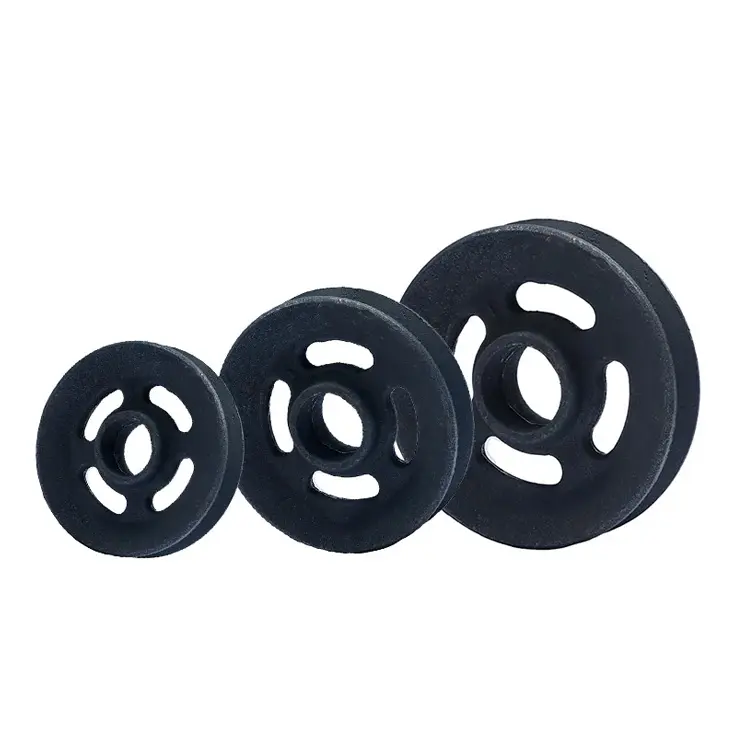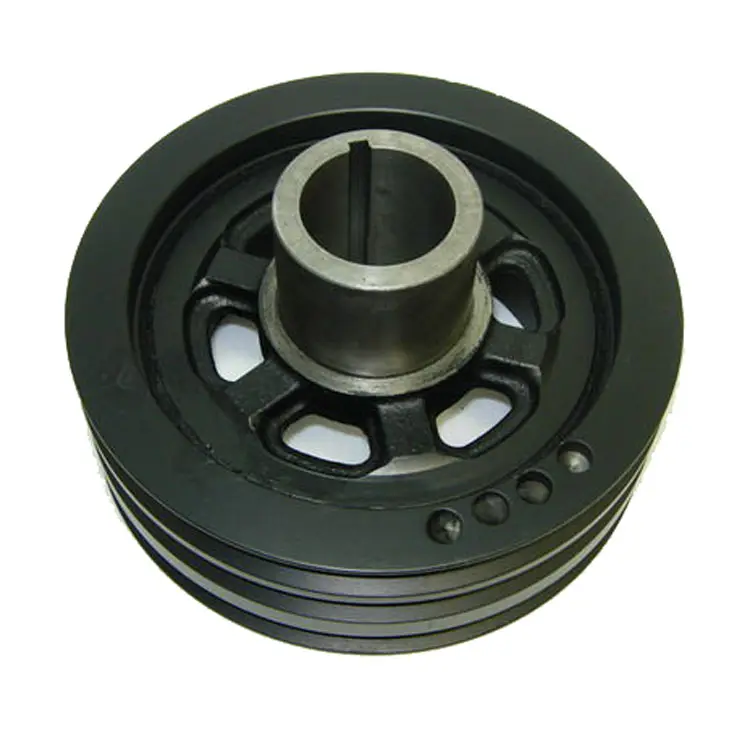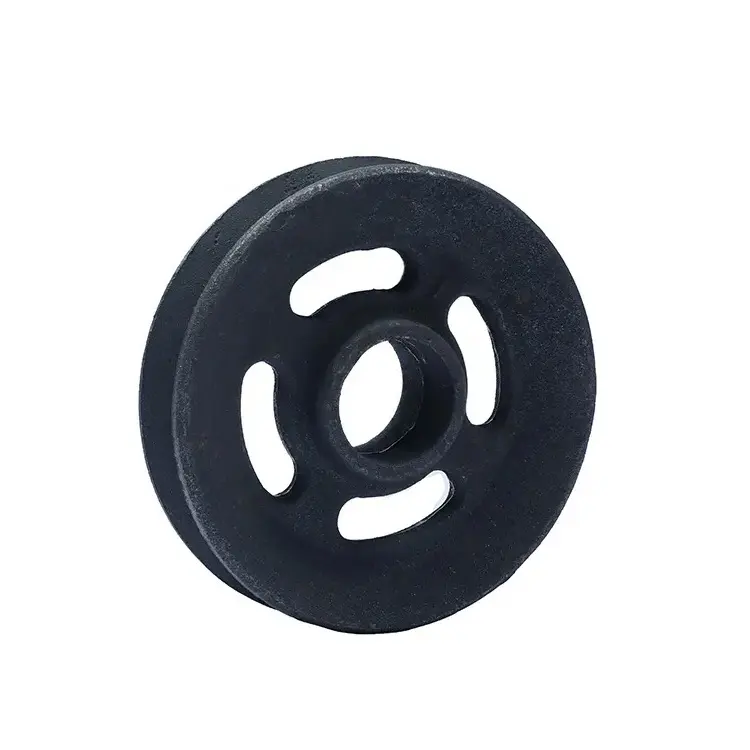Product Description
Grooved Sheave Wheel Aluminum Plastic Taper Lock Bush Idler Flat Poly V belt Adjustable Crankshaft Alternator Tension Agricultural Synchronous Timing Pulley
Timing pulley
V- belt pulley
V- belt pulley of different types ( according to type and width of belts). The material used is cast iron EN-GJL-250 CHINAMFG EN 1561, and for only a few types it is steel C45 E CHINAMFG EN 10083-1. They have a small prebore that can be machined according to customers’ requirements. Moreover the most common types are available also with taperlock bore.
V belt pulley specifications
·
European standards :
a) V-belt pulley for taper bushing: SPZ, SPA, SPB, SPC, up to 10 grooves
b) Adjustable speed V-belt pulleys and variable speed pulleys
c) Flat belt pulleys and conveyor belt pulleys
· American standard:
a) Sheaves for taper bushing: 3V, 5V, 8V
b) Sheaves for QD bushings: 3V, 5V, 8V
c) Sheaves for split taper bushing: 3V, 5V, 8V
d) Sheaves for 3L, 4L or A, and 5L or B belts: AK, AKH,2AK, 2AKH, BK, BKH,2BK, 2BKH, 3BK
e) Adjustable sheaves: poly V-pulley, multi-pitch H, L, J, K and M
· Bore: pilot bore, finish bore, taper bore, bore for QD bushing
– Parts can be made according to drawings and/or samples
· we can offer the rang size diameter 62MM~2000MM
Agricultural pulleys
If the belt pulley of your agricultural machinery is damaged or aged, you can buy a perfectly matched replacement here. Our belt pulley can adapt to the following brands:jo hn dee re, ca se-IH, Kub ota, welger, MTZ…
Company Profile
| Certification: | CE, ISO |
|---|---|
| Pulley Sizes: | Type A |
| Manufacturing Process: | Casting |
| Material: | Iron |
| Application: | Chemical Industry, Grain Transport, Mining Transport, Power Plant |
| The Rang Size Diameter: | 62mm~2000mm |
| Samples: |
US$ 999/Piece
1 Piece(Min.Order) | |
|---|
What maintenance procedures are necessary to keep sheave pulleys in good condition?
To keep sheave pulleys in good condition and ensure their optimal performance, several maintenance procedures should be followed. Here is a detailed explanation of the necessary maintenance procedures:
1. Regular Inspection: Conduct regular visual inspections of the sheave pulleys to check for any signs of wear, damage, or misalignment. Look for cracks, corrosion, excessive groove wear, or any other issues that may affect the pulley’s functionality. Inspections can help identify potential problems early on and prevent further damage.
2. Cleaning: Clean the sheave pulleys regularly to remove dirt, debris, or built-up residue that may impair their operation. Use a soft brush or cloth to gently clean the pulleys and ensure they are free from any obstructions. Avoid using harsh cleaning agents that could damage the pulley’s surface.
3. Lubrication: Apply lubrication to the sheave pulleys to minimize friction and reduce wear. Use a suitable lubricant recommended by the manufacturer or a lubricant specifically designed for pulleys. Apply the lubricant sparingly and distribute it evenly along the pulley’s grooves and edges. Excess lubrication should be wiped off to prevent accumulation of dirt and debris.
4. Tension Adjustment: Check the tension of the cables or belts running on the sheave pulleys. Improper tension can lead to slippage, premature wear, or reduced performance. Follow the manufacturer’s guidelines or consult a professional to ensure the appropriate tension is maintained. Adjust the tension as necessary to maintain optimal operation.
5. Alignment: Ensure that the sheave pulleys are properly aligned with the cables, belts, or tracks they interact with. Misalignment can cause uneven wear, increased friction, and reduced efficiency. Check for any deviations in alignment and make necessary adjustments to ensure smooth and consistent operation.
6. Replacement: If any signs of significant wear, damage, or deterioration are detected during inspections, consider replacing the sheave pulleys. Worn or damaged pulleys may compromise the performance and safety of the system. Follow the manufacturer’s recommendations for replacement parts and procedures.
7. Professional Maintenance: For complex systems or in cases where specialized knowledge is required, it is advisable to seek professional maintenance services. Professional technicians can perform more comprehensive inspections, carry out advanced maintenance procedures, and address any specific issues related to the sheave pulleys.
Remember to consult the manufacturer’s documentation and guidelines for specific maintenance instructions and recommendations tailored to the sheave pulleys used in your particular system. Adhering to regular maintenance procedures will help extend the lifespan of the sheave pulleys, ensure their efficient functioning, and contribute to the overall reliability and safety of the system.
How does the size and design of a sheave pulley impact its performance?
The size and design of a sheave pulley have a significant impact on its performance in various applications. Here is a detailed explanation of how the size and design of a sheave pulley affect its performance:
1. Mechanical Advantage: The size of a sheave pulley directly affects the mechanical advantage it provides. A larger diameter sheave pulley offers a greater mechanical advantage, allowing for higher torque or force amplification. This is particularly important in applications where heavy loads need to be lifted or moved. Conversely, a smaller diameter sheave pulley provides a lower mechanical advantage but allows for higher rotational speed. The selection of the appropriate sheave pulley size is crucial to achieving the desired balance between torque and speed in the system.
2. Speed and Torque Ratio: The size ratio between the driving and driven sheave pulleys determines the speed and torque ratio in belt and chain drive systems. By varying the diameter of the sheave pulleys, the rotational speed of the driven component can be adjusted relative to the driving component. A larger driven sheave pulley compared to the driving sheave pulley results in higher torque but lower speed, while a smaller driven sheave pulley leads to higher speed but lower torque. The proper sizing and design of the sheave pulleys are critical in achieving the desired speed and torque characteristics of the system.
3. Belt or Chain Compatibility: The design of a sheave pulley should be compatible with the type and size of the belt or chain being used. The grooves and profile of the sheave pulley should match the corresponding belt or chain, ensuring proper engagement and minimizing slippage. A well-designed sheave pulley provides sufficient grip on the belt or chain, maximizing power transmission efficiency and preventing premature wear or failure of the system.
4. Material Selection: The design of a sheave pulley also includes the choice of materials. The material selection depends on factors such as the load-bearing capacity, environmental conditions, and desired friction characteristics. Common materials for sheave pulleys include steel, cast iron, aluminum, and various polymers. The material should possess the necessary strength, durability, and resistance to wear, corrosion, or temperature variations, ensuring reliable performance and longevity of the sheave pulley.
5. Groove Configuration: The design of the grooves in a sheave pulley is crucial for proper cable or belt tracking. The groove configuration should match the shape and size of the cable or belt to ensure effective engagement and prevent slipping or misalignment. Different groove profiles, such as V-shaped, U-shaped, or flat, are used depending on the application requirements. The correct groove design promotes efficient power transmission, reduces wear on the cables or belts, and minimizes noise and vibration.
6. Bearing and Lubrication: The design of a sheave pulley should consider the bearing arrangement and lubrication requirements. Proper bearing selection and lubrication ensure smooth rotation and reduce frictional losses. The design should allow for easy access to the bearing for maintenance and replacement. Additionally, provisions for lubrication, such as grease fittings or oiling points, should be incorporated to ensure optimal performance and longevity of the sheave pulley.
7. Load Capacity: The size and design of a sheave pulley determine its load-bearing capacity. A well-designed sheave pulley can handle the anticipated loads without deformation or failure. The material strength, groove profile, and overall structural integrity of the sheave pulley should be carefully considered to ensure safe and reliable operation under the expected loads.
Overall, the size and design of a sheave pulley directly impact its performance. Factors such as mechanical advantage, speed and torque ratio, belt or chain compatibility, material selection, groove configuration, bearing and lubrication requirements, and load capacity must be carefully considered in the design process to achieve optimal performance, efficiency, and reliability in various applications.
What are the primary components and design features of a sheave pulley?
A sheave pulley consists of several primary components and design features that are essential to its functionality. Here is a detailed explanation of the primary components and design features of a sheave pulley:
1. Wheel or Disk: The main body of a sheave pulley is typically a wheel or disk-shaped component. It is usually circular in shape, with a central axle or hub. The wheel or disk provides the structural support and rotational motion required for the pulley to function.
2. Grooves: Sheave pulleys feature one or more grooves on their outer circumference. The grooves are specifically designed to accommodate belts, ropes, or cables. The number and configuration of the grooves depend on the intended application and the type of belt or rope that will be used with the pulley. The grooves ensure proper alignment and grip, preventing slippage and enabling efficient power transmission or lifting operations.
3. Axle or Hub: The axle or hub is the central component of the sheave pulley. It provides the rotational axis around which the wheel or disk rotates. The axle or hub is typically mounted on a shaft or bearing, allowing the pulley to rotate freely.
4. Bearings: In some sheave pulleys, bearings are incorporated into the design to reduce friction and enable smooth rotation. The bearings are usually located within the axle or hub, allowing the pulley to rotate with minimal resistance. The use of bearings enhances the efficiency and durability of the sheave pulley.
5. Material: Sheave pulleys are commonly made from various materials, depending on the specific application and operating conditions. Common materials used for sheave pulleys include metals such as steel or cast iron, as well as synthetic materials like nylon or high-density polyethylene (HDPE). The choice of material depends on factors such as load capacity, environmental conditions, and desired durability.
6. Size and Configuration: Sheave pulleys come in various sizes and configurations to accommodate different system requirements. The size of the pulley is determined by factors such as the load capacity, belt or rope thickness, and the desired speed of rotation. Additionally, the configuration of the pulley, including the number and arrangement of grooves, can vary depending on the specific application and the type of belt or rope used.
7. Mounting: Sheave pulleys are typically mounted on a shaft or bearing housing to ensure proper alignment and stability. The mounting mechanism may involve set screws, keyways, or other fastening methods to secure the pulley in place. Proper mounting is crucial to ensure smooth rotation and prevent any misalignment or wobbling that could affect the performance of the pulley.
In summary, the primary components and design features of a sheave pulley include the wheel or disk, grooves for accommodating belts, ropes, or cables, the axle or hub for rotational motion, bearings for reducing friction, the choice of material for durability, size and configuration variations, and the mounting mechanism for proper alignment. These components and design features work together to enable efficient power transmission and lifting operations in various mechanical systems.
editor by CX
2023-09-19




